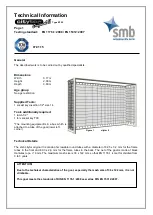
3
Choosing a Setup Location
1. Choose a clear area to set up the slackline. A healthy tree with a 38 in. (97 cm) circumference or 12 in. (30.5 cm) diameter is
recommended.
2. If using a pole or post, be sure that it can withstand at least 2,500 lbs. (1,134 kg) on each end.
3. Select a location that is easily supervised, such as the backyard within viewing distance of a window.
4. It is not recommended to set up over swimming pools, ponds, streams, or rivers.
For best results, set up the slackline over soft grass that is clear of bushes, rocks, or anything else that may cause injury.
It is also recommended to place cushioning materials under and around the slackline in case of falling.
Installing the Slackline
1. To determine the height of the course, have the shortest user reach up above their head as high as possible.
2. Measure the height from the ground to the fingertips, then add an additional 24 in. (62 cm). This should allow for 12 in.
(62 cm) of clearance from the ground when the line is in use.
3. After selecting two trees, wrap the ratchet and its line around the one with a smaller diameter. Lead the ratchet through
the looped end of the line as seen below. Be sure to keep the line flat as you lead it through.
4. Pull the ratchet until the line is securely in place, as seen below.
5. Take the other line and, and using a stable step ladder, wrap it around the other tree. Tighten the line, while keeping it
flat and not twisted. Pull the loose end of the line through the looped end as seen below.
6. Repeat this same process with the walking slackline suspending it 24 in. (62 cm) above the ground.
Obstacle Course Setup
1. Note the location of each sewn-in delta clip pocket on the slackline.
This is where the obstacles can be attached.
Never attach the obstacles anywhere else on the slackline.
2. Open the delta clip on each obstacle you wish to use by twisting the lock open.
3. Attach each obstacle using the attached delta clips, keeping in mind how far the intended
user will be able to reach. Slip each delta clip into the sewn-in pocket, then lock the delta clips.
Delta Clip

























